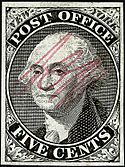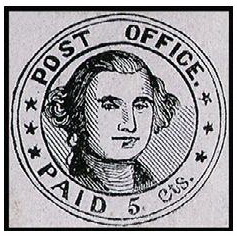New York Postmaster's Provisional facts for kids
The New York Postmaster's Provisional is a special postage stamp. It was created by the New York Post Office. This stamp helped people pay for their mail before the United States had its own national stamps. It went on sale on July 14, 1845. This was the first local stamp issued in the country. It came out after a new postal law from Congress. This law, passed on March 3, 1845, made mail prices the same everywhere. This made using stamps a good way to pay for mail. Before this law, mail prices were different in many places. So, the person getting the letter usually paid for it, not the sender. Baltimore and New Haven also issued their own stamps soon after New York. The New York stamp is known as "the most beautiful and popular" of these early local stamps. Eleven different US post offices issued these stamps between 1845 and 1847.
Quick facts for kids New York Postmaster's Provisional |
|
|---|---|

New York Postmaster's Provisional
|
|
| Country of production | United States of America |
| Location of production | New York, NY |
| Date of production | 1845-47 |
| Printer | Rawdon, Wright and Hatch |
| Depicts | George Washington |
| Notability | Most elegantly executed of the U. S. provisionals |
| No. in existence | thousands are known |
| Face value | 5¢ |
| Estimated value | $500-$11,000 |
Making the Stamp
The New York Postmaster, Robert H. Morris, started making this stamp soon after he took office. He became Postmaster on May 21, 1845. He had also been the Mayor of New York before this.
Morris hired a top printing company called Rawdon, Wright & Hatch. This company was known for printing banknotes. They designed the stamp using a picture of George Washington by Gilbert Stuart. The company made a printing plate that could print forty stamps at once. Experts first thought it printed fifty or one hundred stamps. But in 1921, a stamp expert named Abraham Hatfield showed it was forty stamps. They were in eight rows of five.
Morris received the first stamps on June 12. He also got a bill for $55.01. That same day, he sent letters with a sample stamp to postmasters in Boston, Philadelphia, Albany, and Washington. Here is part of what he wrote:
My dear sir,
I have adopted a stamp which I sell at 5 cents each. The accompanying is one. ... Your office of course will not officially recognize my stamp, but will be governed only by the post office stamp of prepayment. Should there by any accident be deposited in your office a letter directed to the City of New York with one of my stamps upon it, you will mark the letter unpaid, as though no stamp was on it, though when it reaches my office, I shall deliver it as a paid letter. In this manner, the accounts of the offices will be kept as now. ...
Other cities offered stamps with different values. For example, Providence had 5¢ and 10¢ stamps. The St. Louis Bears stamps came in 5¢, 10¢, and 20¢ values. But Morris decided that one stamp value was enough for New York. The 5¢ price covered mail sent up to three hundred miles. Most of New York's mail did not go further than that. This was different for cities like Providence or St. Louis, which were farther away.
New York was home to many top printing companies. These companies made banknotes and other important papers. So, it's not surprising that New York's stamp was very well made. Smaller cities did not always have such advanced printing places. For example, the Millbury, MA post office made its own stamp in 1846. It also showed George Washington. But it was printed from a wood-cut, which was a simpler method.
These local stamps helped people get used to using stamps to pay for mail. This prepared them for when the national stamps would come out. The New York stamp played a big part in this process.
How the Stamp Was Used
The New York Provisional stamp came out on July 14, 1845. It was the first stamp ever issued by a local US Postmaster. People quickly accepted it. Stamps have even been found on letters dated July 15. New Yorkers were already familiar with stamps. Private mail companies had offered stamps before. They were also used to seeing stamps with George Washington's picture.
In February 1842, a New York company called the City Despatch Post printed a 3¢ Washington stamp. It was for their customers. This was the first sticky postage stamp made in the Western Hemisphere. The company offered a second version of that stamp later. This happened when the US Post Office bought the company.
The New York Provisional stamp could only be bought at the city's post office. To make sure the stamps were real, the Postmaster or his helpers wrote their initials on each one in red ink. Postmaster Morris's initials, "RHM," are on only a few stamps. Most of the work fell to his Assistant Postmaster, Alonzo Castle Monson. Alonzo was 23 years old. His initials, "ACM," are on most of the stamps.
These stamps were used a lot. Rawdon, Wright & Hatch sent eighteen batches of stamps to the New York Post Office. The last shipment was on January 7, 1847. This brought the total number of stamps delivered to 143,600. The stamp's design and quality were so good that the US Post Office hired the same company to print the first national stamps. This happened a few months later. The company was now called Rawdon, Wright, Hatch and Edson. They were hired without the usual bidding process.
The first US national postage stamps came out on July 1, 1847. This meant that local stamps like the New York Provisional were no longer needed. For the 1847 US stamps, the printer made a design similar to the provisional. But it was more than 20% smaller. No later US stamp was as large as the New York Postmaster's Provisional.
What Makes Them Special Today
New York Postmaster's Provisional stamps come in many different types. Their value can vary a lot for collectors. The postmaster wanted to prevent fake stamps. So, he and his assistants initialed each stamp. This created several different ways the stamps were marked.
In the Scott catalogue, which lists stamp values, used stamps with the common "ACM" initials are worth about $500. But this value goes up if the "ACM" letters are connected or have periods between them. Stamps without any initials are worth even more. Stamps with Postmaster Robert H. Morris's "RHM" initials are worth several thousands of dollars. The rarest initials are "MM" or "MMJr." These belonged to Alonzo's older brother, Marcena Monson Jr. Stamps with these initials are worth a lot more.
Unused stamps are also worth more, especially those with their original glue. These are very rare. Most of the stamps were printed on a bluish paper. But sometimes, different types of paper are found. Stamps on these different papers can also be very expensive.
These stamps have always been popular with collectors. For example, Henry G. Lapham won a gold medal in 1926. He won it at the New York International Philatelic Exhibition. His collection had over 700 New York Postmaster's Provisionals. This included six with the rare "RHM" initials. He also had a full sheet of forty stamps put together.


